December 1, 2006
Air Date: December 1, 2006
FULL SHOW
SEGMENTS
Conflicting Interests
View the page for this story
A new study finds a number of the world’s leading cancer scientists were secretly receiving money from companies whose products they were investigating. Living on Earth host Bruce Gellerman talks with Dr. Lennart Hardell, principle author of “Secret Ties to Industry and Conflicting Interests in Cancer Research.” LOE then turns to Dr. Catherine DeAngelis, editor-in-chief of the Journal of the American Medical Association, and epidemiologist Richard Clapp of Boston University to discuss conflict of interest and corporate funding of medical research. (12:00)
* WEB EXTRA* Harvard Scientist Responds to Allegations
View the page for this story
Living on Earth host Bruce Gellerman talks to Dr. Dimitrios Trichopoulos of the Harvard School of Public Health, one of the scientists cited in Dr. Lennart Hardell’s article alleging financial conflict of interest. (11:00)
High Court Considers Climate Change
/ Jeff YoungView the page for this story
Living on Earth's Jeff Young reports on what some call the most important environmental case the Supreme Court has ever heard. The Justices will decide if greenhouse gases from autos and trucks must be considered pollutants, and whether the Environmental Protection Agency has to regulate them. (06:40)
Eco-friendly Autos
/ Ingrid LobetView the page for this story
After fighting a mandate for electric cars in California, and pulling its own electric cars out of production, General Motors Chairman Rick Wagoner has had a change of heart. He told attendees of the L.A. Auto show that electric cars will probably steer the future of the automobile and GM will bring a new EV on line. Living on Earth’s Ingrid Lobet reports. (02:30)
Raging Rivers
View the page for this story
Author Jeffrey Tayler takes us on a journey down the Lena River into the wilds of Siberia. He shares tales from his new book “River of No Reprieve; Descending Siberia’s Waterway of Exile Death, and Destiny.” (09:00)
Energy Brat?
View the page for this story
Youth Radio’s Antony Jaurequi didn’t give a lot of thought about how much energy he wastes until he found himself in his parents’ hometown in Mexico. The visit gave him a new appreciation for energy conservation. (05:30)
Green Fashionista
View the page for this story
Model Summer Rayne Oakes is more than just a pretty face. Oakes is also an expert on sewage sludge and a sustainable fashion consultant. She gives host Bruce Gellerman the skinny on turning bamboo into haute couture and why we should wear earth-friendly clothing. (07:15)
Green Giving
View the page for this story
Kara DiCamillo of treehugger.com gives host Bruce Gellerman green gift tips for the holiday season. (04:30)
This week's EarthEar selection
listen /
download
A Mongolian musician plays a horsehair fiddle in Russia.
Show Credits and Funders
Show Transcript
HOST: Bruce Gellerman
GUESTS: Dr. Richard Clapp, Dr. Catherine DeAngelis, Kara DiCamillo, Dr. Lennart Hardell, Summer Rayne Oakes, Jeffrey Tayler
REPORTER: Jeff Young, Ingrid Lobet, Antony Jaureguí
[THEME]
GELLERMAN: From Public Radio International - this is Living on Earth.
[THEME]
GELLERMAN: I’m Bruce Gellerman. A new study reveals secret ties between some of the world’s leading cancer researchers and chemical companies. The editor of a major medical journal calls conflict of interest a huge problem.
DeANGELIS: I think this is one of the biggest problems in medicine today because it affects the research, which affects the practice of medicine, which ultimately affects patient care.
GELLERMAN: Also, a dozen states, including Massachusetts, have their day in the U.S. Supreme Court, charging the federal government must do something about global warming.
REILLY: It’s unfortunate that the Commonwealth of Massachusetts had to be here today to force the EPA and the administration to do their jobs.
GELLERMAN: And, we wrap-up green gifts for the holiday season. That and more this week on Living on Earth. Stick around!
[NPR NEWSCAST]
ANNOUNCER: Funding for Living on Earth comes from the National Science Foundation and Stonyfield Farm.
Conflicting Interests
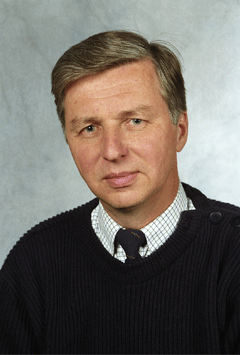
Dr. Lennart Hardell works in the Department of Oncology at the Örebro Medical Centre, in Örebro, Sweden (Courtesy of Dr. Lennart Hardell)
GELLERMAN: From the Jennifer and Ted Stanley Studios in Somerville, Massachusetts - this is Living on Earth. I’m Bruce Gellerman. A new study charges some of the world’s most prestigious cancer researchers were secretly receiving money from major chemical corporations. The allegations of conflict of interest appear in the latest edition of the American Journal of Industrial Medicine, and it names names. The lead author of the article is Swedish scientist Lennart Hardell. Professor Hardell, thank you very much for joining us.
HARDELL: Thank you.
GELLERMAN: Now, in your articles you found that some of the world’s leading scientists were secretly on the take from companies that were funding research.

Dr. Lennart Hardell works in the Department of Oncology at the Örebro Medical Centre, in Örebro, Sweden (Courtesy of Dr. Lennart Hardell)
GELLERMAN: Well, in one case that you cite you have Dr. Richard Doll who was the researcher who originally found the link between smoking and cancer and you found that he was on the take from Monsanto for, what, over 20 years.
HARDELL: Yes, and we were quite shocked when we found that because he was a very well reputated cancer researcher who has unfortunately passed away by now.
GELLERMAN: You found that while he was receiving a thousand dollars a day from Monsanto was testifying that vinyl chloride had no consequences in terms of workers who were dealing with vinyl chloride and getting cancer. And yet the link was quite evident.
HARDELL: Yes it was quite evident and also WHO has considered vinyl chloride to be a carcinogenic product and still Sir Richard Doll said there was no problem. So with this background now knowing that he was secretly hired by Monsanto, so that might be one explanation for his standpoint on that special issue.
GELLERMAN: But, basically, what you’re saying is that this was the best science, or scientist, that money could buy.
HARDELL: Yes, unfortunately.
GELLERMAN: The golden rule here applies. You know, that he who has the gold rules.
HARDELL: Yes and this gives a different light on their findings their reports and their work for different governmental agencies.
GELLERMAN: You implicate some of the leading scientific researchers in the world and some of the leading academic science organizations in the world. How could it be?
HARDELL: Well, that’s difficult that you have people in such positions who want to be powerful; who want to have big organizations and do much research and then you need much money. And if you don’t get the money from granting organizations then you have to go to industry because that’s where money is.
GELLERMAN: But if you have these types of professors and researchers people at the height of their game in their fields being able to be persuaded to, well, taint their research for money, who isn’t susceptible?
HARDELL: Well, that’s really a problem. Anyone could be susceptible if there’s enough money on stake. From my point of view it’s quite ok to work for industry but then you should declare because this is a conflict of interest. So, if we see this report on vinyl chloride from Dahl he should have said at the end of the paper that he wrote that, “actually I was paid by Monsanto” there’s a conflict of interest here.
GELLERMAN: So it’s not a problem accepting money but you just have to tell the public that that’s what you’re doing?
HARDELL: Yes. You tell the public what you’re doing and the public can make their own conclusions. And also other researchers can make their conclusions. I’m not saying that it should be forbidden for university researchers to do work for industry but then you should report it to your employer and also report it in your publications, of course.
GELLERMAN: There was a study recently done that shows a third of all the original research published in the New England Journal of Medicine and the Journal of the American Medical Association was funded by for-profit health care companies. That’s not cause for concern then?
HARDELL: Well, it is of concern that this research type is not independent and not all researchers report, obviously, this connection to industry. But this biggest concern is, of course, the reports that show that industry funded research tends to show no risk from the product they are studying. There’s quite a clear difference. I’m doing work on mobile phones and brain tumor risk. And when we look into industry-sponsored studies versus those coming from independent groups there’s quite a difference of the results. Namely, that industry sponsored research tends to show no risk where as other ones show that there is something going on.
GELLERMAN: So, Dr. Hardell, what should be done so that we don’t have these types of horror stories in the future? Can anything really be done?
HARDELL: Well, I’ve been working in cancer epidemiology for 30 years and also seeing the cancer patients on a daily basis and I’m rather pessimistic what we can really do in the future because these are such extremely strong forces and there’s economical power in research. In the best of worlds of course everything should be governmentally funded research or by independent grant funding organizations. But we don’t have that situation, so we have to live and somehow try to sort it out by having pressure on the journals to disclose all of these scientific conflicts and also from the scientists themselves to disclose if there are any such problems.
GELLERMAN: Dr. Hardell, thank you very much. It was a real pleasure talking to you.
HARDELL: Thank you.
GELLERMAN: Professor Lennart Hardell is principle author of the study “Secret Ties to Industry and Conflicting Interests in Cancer Research.” Monsanto was unable to provide a response to our story in time for our broadcast. You can check our website: loe.org for an update.
So, just how big a problem is conflict of interest in medical research? We turn to Boston University epidemiologist Richard Clapp and Dr. Catherine DeAngelis editor –in-chief of the Journal of the American Medical Association. Well, Dr. DeAngelis, the question is to you: how big a problem is it?
DeANGELIS: Huge. I think this is one of the biggest problems in medicine today, because it affects the research, which of course then affects the practice of medicine, which ultimately affects patient care.

Dr. Catherine DeAngelis is the Editor-in-Chief of the Journal of the American Medical Association.
(Courtesy of JAMA)
GELLERMAN: So Dr. DeAngelis, what is the journal of American Medical Association doing about conflict of interest?
DeANGELIS: What we are doing is, first of all, we insist that every author must disclose fully any potential or real conflict of interest. I say to the authors it’s like doing a spinal tap. If you think about doing it you’d better do it. Then it’s up to us to determine whether or not we should publish it. If they don’t disclose it and I discover it I insist that the author writes a letter of apology to our readers.
CLAPP: I would add though that the reviewers sometimes are able to put in their two cents on whether there’s a conflict. The reviewers may know the authors or at least know the content around which the article is built and so that adds to this disclosure as well.
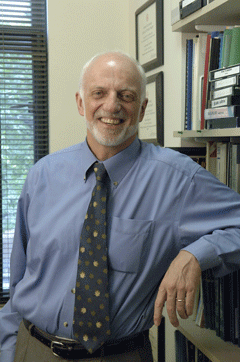
Professor Richard Clapp is an epidemiologist and Professor of Environmental Health at Boston University’s School of Public Health.(Courtesy of Boston University School of Public Health)
DeANGELIS: Absolutely. I think that the vast, vast majority of authors, principle investigators, researchers, reviewers, are completely honest. It is just a very small percentage who really have made this problematic. And the problem is, I think, a much more substantial proportion of clinicians have become involved with either pharmaceutical companies or medical device companies. These are for profit companies, physicians say oh that doesn’t affect my practice. And my response is, “Believe me, if the pharmaceutical company didn’t think it affected your practice they wouldn’t be spending literally hundreds of millions of dollars on paying for these little perks, if you will.” I think it’s ridiculous.
GELLERMAN: Yeah but so far, Dr. DeAngelis, what I hear is kind of physicians and physicians magazine heal thy selves. I don’t hear anybody from the outside doing anything. That is, getting tough on the drug companies.
DeANGELIS: Well, ah, stay tuned.
CLAPP: There have been suggestions that there be a national institute for clinical trials for this kinda thing so that it’s actually government funded research on new drugs and new devices.
GELLERMAN: So companies would pay the government and the government would fund the studies.
CLAPP: Yes or put their money into a fund, a pool and, and not exactly pay the government to fund a particular study.
GELLERMAN: Did you ever have a company try to influence your research?
CLAPP: Never had a company try to influence the research. I have had companies, you know, extremely upset, upset with the results of my research and try and prevent it from being published.
GELLERMAN: Were they ever successful?
CLAPP: Nope.
GELLERMAN: So, the system works?
CLAPP: In some sense. It’s a battle. I wouldn’t say it’s an easy walk to freedom so to speak. It can be made to work but I think you have to be determined if you’re the researcher and you have to be vigilant if your the watchdog.
GELLERMAN: But, but I’m reminded that the former head of the Food and Drug Administration, Lester Crawford, just pleaded guilty 2 months ago to failing to disclose his financial interest in health care companies that were governed by his agency.
DeANGELIS: Big surprise. Were you surprised by that?
CLAPP: I wasn’t.
DeANGELIS: I mean come on. I mean as long we tolerate and do not clamp down on people who are doing this, which is blatantly dishonest, it’s going to continue.
GELLERMAN: So what about your journal? I leaf through it and I see, you know, one third is articles and two thirds ads for drug companies.
DeANGELIS: Ok. Let me tell you about that. If it were up to me I would not allow any ads in our journal. However, it costs a lot of money to do what we do and putting out a journal like that. And so the one thing we do is we separate the advertising. That’s all done by the publisher. We have the strictest rules for advertising. One of our rules is you can never sell an ad to a specific issue. That happened while, during my first six months here and I got a call from the advertising group that sells and they said Dr D., this company wants to advertise this four-page ad. And I said wait a minute, and they said, cause it’s in one issue and I said wait a minute, we don’t do that. And they said no, no. They want it in that issue. So I looked at the issue. We work five six weeks ahead. Sure enough there was an article in there for a product by this company. And I thought about it for a minute and I said alright, we’ll take it. And they said really? I said sure. It was a big ad. And then I moved the article ahead two weeks.
CLAPP: Another approach is online and or what’s called open access journals where the, the person who’s submitting the article actually has to pay for it to be put online and, and actually pays for the peer review process.
DeANGELIS: Sure, but let me tell you what’s wrong with that. It’s unfair to those authors who don’t have money to pay for their article to go online. That is very poor practice.
CLAPP: Well, it’s a widely accepted and growing practice.
DeANGELIS: I know, I know. So is cancer. It’s widely growing and it’s, sometimes I look at it as the same effect. This is, this is a terrible issue and it’s something that we can do something about but we all have to do it together.
GELLERMAN: Dr. De Angelis I want to thank you very much.
DeANGELIS: Thank you so much.
GELLERMAN: Dr. Catherine DeAngelis is editor-in- chief of the Journal of the American Medical Association. Dr. Clapp, thank you very much.
CLAPP: You’re welcome.
GELLERMAN: Richard Clapp is an epidemiologist at Boston University.
Related links:
- “Secret Ties to Industry and Conflicting Interests in Cancer Research” in The American Journal of Industrial Medicine
- The Journal of the American Medical Association
- National Institute of Health Conflict of Interest Page
- News brief of UCLA study on disclosure policies of biomedical journals to be published in the December issue of the Journal of General Internal Medicine
[MUSIC: Ian Boddy “Stormfront” from ‘Elemental’ (DIN – 2006)]
GELLERMAN: Coming up: The Supreme Court judges climate change. Just ahead on Living on Earth.
[MUSIC: Christmas Baubles “Slowly” from ‘Christmas Baubles and Their Strange Sounds’ (Lo Recordings - 2006)]
* WEB EXTRA* Harvard Scientist Responds to Allegations
In his article, “Secret Ties to Industry and Conflicting Interests in Cancer Research, Dr. Lennart Hardell alleges some of the most famous epidemiologists in the world had not disclosed their financial ties to chemical companies.
Among those cited is Dr. Dimitrious Trichopoulos of Harvard School of Public Health. Dr. Hardell charges Dr. Tricholopoulos failed to disclose his ties to a consulting firm representing a chemical manufacturer at a conference in 2001.
Living on Earth host Bruce Gellerman spoke with Dr. Trichopoulos about the allegation.
Related link:
Harvard Scientist Response Audio
High Court Considers Climate Change
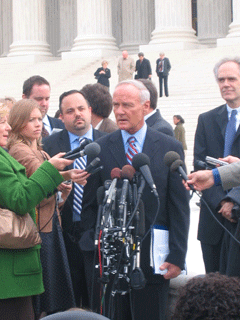
Massachusetts Attorney General Tom Reilly (center) and Assistant Attorney General Jim Milkey (right) greet the press in front of the U.S. Supreme Court. (Photo: Massachusetts Attorney General's Office)
GELLERMAN: It’s Living on Earth. I’m Bruce Gellerman. Climate change was on the docket when the U.S. Supreme Court judges heard arguments on whether the Environmental Protection Agency has to treat greenhouse gases as pollutants contributing to global warming. A dozen states say yes; the Bush administration insists no. Living on Earth’s Jeff Young was in the court during oral arguments and has our story.
YOUNG: The Supreme Court is not where David Bookbinder wanted to take the fight against global warming. The Sierra Club attorney would rather have action from Congress, or the President, not the courts.
BOOKBINDER: Trying to address climate change by suing federal regulatory agencies is the least efficient way of dealing with climate change. Unfortunately it’s the only path we have right now.
YOUNG: Lawmakers are deadlocked on climate change, and the Bush administration’s EPA says it lacks any authority to regulate greenhouse gases. So environmentalists and attorneys general for 12 states joined a lawsuit to force the agency to act. The suit says EPA must treat carbon dioxide from autos as pollutants under the Clean Air Act, which would likely lead to regulating the gas.
[COURT PLAZA SOUNDS]
YOUNG: And on an unusually warm late November day, global warming had its day in the country’s highest court.
REILLY: It’s unfortunate that the commonwealth of Massachusetts had to be here today to force the EPA and the administration to do their jobs.

Massachusetts Attorney General Tom Reilly (center) and Assistant Attorney General Jim Milkey (right) greet the press in front of the U.S. Supreme Court.(Photo: Massachusetts Attorney General's Office)
Appropriately enough, it was what court observers call a "hot bench"— all but one of the Justices had sharp questions for Milkey and administration attorney Greg Garre. Garre repeated EPA’s claim that the science of climate change was too uncertain to justify regulation. Justice John Paul Stevens said many scientists disagreed, and thought EPA had misrepresented what is a scientific consensus. Then Justice Antonin Scalia, the court’s leading conservative, agreed with a key point in Milkey’s argument for Massachusetts and the environmentalists--that Carbon dioxide fits the definition of a pollutant. Georgetown law professor Lisa Heinzerling wrote the brief for Massachusetts.
HEINZERLING: Justice Scalia, who began with a phrase that made my heart sing, which was ‘to be sure CO2 is a pollutant.’ At that point I thought maybe we should sit down. (laughter)
YOUNG: But before they could sit, the states and environmentalists had to deal with something called standing. Standing is the legal principle that you can only sue in federal court if you can show that, (a), you’ve been harmed, and, (b), the court’s action would help. Justices Scalia, Samuel Alito and Chief Justice John Roberts were all skeptical.
Scalia wondered if the threat of global warming was imminent. "When is the predicted cataclysm," he asked. Massachusetts’s attorney Milkey said the harmful effects of CO2 in the atmosphere were imminent in the way that "lighting a fuse on a bomb is imminent."

The Supreme Court will decide upon whether or not carbon dioxide emitted from automobiles should be classified as a pollutant.(Courtesy of the Department of Transportation)
MILKEY: Massachusetts owns 200 miles of coastline that is being inundated by rising seas. That harm is occurring today and it’s gonna happen tomorrow and get worse as greenhouse gases continue to accumulate in the atmosphere.
YOUNG: But Justices Roberts and Alito pointed out that the case deals with US auto emissions, and that’s only about 6 percent of the global CO2 picture.
The justices wondered if reducing only the CO2 from new US autos would make any difference. That’s a question attorney Scott Segal happily repeated on the court’s plaza.
[COURT PLAZA SOUNDS]
SEGAL: If the commonwealth of Massachusetts wins, will it be hotter or cooler in 5 years? I bring that up because it goes straight to the issue of standing.
YOUNG: Segal is with the powerful K Street law firm Bracewell and Giuliani, which represents many coal-burning power companies. Even though this case deals only with autos, it could open the door to regulation of CO2 from power plants. Segal says the Massachusetts case tries to force the square peg of global warming into the round hole of the clean air act—and the complexity of climate change means it won’t fit.
SEGAL: They have portrayed an incredibly simplistic view of climate science. The notion that you can trace it to a single auto tailpipe and say that saves a single square centimeter of coastline on Cape Cod.
YOUNG: Judging from the Justices’ line of questions the standing issue is the biggest hurdle to the Massachusetts case. And some environmental law experts fret that a ruling on that issue could have broad implications and keep other climate suits from even reaching the courts. However, if the Justices decide on the core question of the case--EPA’s authority to regulate CO2--that could break the logjam on climate change.
Some observers say a ruling for Massachusetts could strengthen efforts by states like California to cap greenhouse gases and perhaps even spur action by the newly elected Congress.
At the least, it could force EPA to revisit its decision. But one former EPA official is confident the agency’s decision not to act on greenhouse gases will stand. Until last year, Jeff Holmstead was EPA’s chief of Air issues.
HOLMSTEAD: It was the decision that I recommended and I think it’s the right decision and I think the Supreme Court will say that as well.
YOUNG: And what do you do now?
HOLMSTEAD: I just started work, I’m a partner with the firm Bracewell and Giuliani.
YOUNG: Yes, that’s the same firm that represents power companies. But Holmstead says there’s nothing wrong with his move from government regulator to representing the regulated.
HOLMSTEAD: I, I’m not sure why, uh, people have tried to make something of that. But people have to have jobs. And that’s the way it works.
YOUNG: The court is expected to rule by the summer. For living on Earth, I’m Jeff Young, at the Supreme Court.
Related links:
- Transcripts of oral arguments in the Supreme Court case Mass. v. EPA
- Georgetown Law School’s Environmental Law and Policy Institute’s overview of global warming in the courts
- Stories from Living on Earth’s archives on the U.S. Supreme Court’s case on climate change:
- “Climate Heads to High Court”
Eco-friendly Autos

General Motors announced it will build a plug-in version of the Saturn VUE Green Line Hybrid SUV. (Courtesy of U.S. Department of Energy)
GELLERMAN: Whatever the Supreme Court decides about the EPA regulating greenhouse gases from autos, General Motors has seen the future of the automobile and now says it’s electric. The company announced its plans at the L.A. Auto Show. Our Western Bureau Chief Ingrid Lobet has our story.
LOBET: In recent years GM has faced disappearing dollars, market share and public confidence. Chairman Rick Wagoner's job is to turn that around. And at the L.A. Auto Show he said cars that run on electricity are a big part of that plan.
WAGONER: In fact I am announcing today that GM is significantly expanding and accelerating our commitment to the development of electrically driven vehicles beyond what we have already committed to with our fuel cell and hybrid programs.
LOBET: Wagoner said gasoline and diesel will be the principle vehicle fuels for some time. And he said GM will be building lots of cars that can fill up on ethanol. But he emphasized electricity-- mentioning IT, or 'electrically-driven' or 'plug-in' cars 34 times in his keynote speech. He seemed to resurrect a technology GM killed just a few years ago, saying consumers weren't interested.

General Motors announced it will build a plug-in version of the Saturn VUE Green Line Hybrid SUV.(Courtesy of U.S. Department of Energy)
LOBET: Wagoner said GM will build a version of its Saturn Vue hybrid that plugs in to recharge, but he gave no timetable.
WAGONER: But I can tell you this is a top priority program for General Motors.
LOBET: Electric car enthusiasts have waited for a major car company to make such an announcement, though announcements without timetables can mean little. And the term "electrically-driven" can be used for anything from fuel cells to diesel hybrids, but Ron Cogan of the Green Car Journal, says just because the term is broad, doesn't mean it's empty PR.
COGAN: It's not really a greenwashing thing really at all. By using electric drive and by committing to it, you are going to that pathway that takes you to a better place.
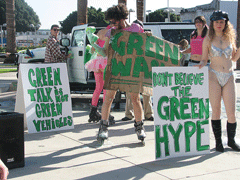
Global Exchange and Rainforest Action Network hold a protest at the LA Auto Show to demand auto manufacturers curb green house gas emissions and catalyze energy independence.(Photo: Nell Greenberg, Global Exchange)
For Living on Earth I'm Ingrid Lobet, in Los Angeles.
Related links:
- LA Auto Show
- Saturn VUE Green Line Hybrid SUV
[MUSIC: Takagi Masakatsu “Ketle, Part 2” from ‘Journal for People’ (Carpark Records – 2006)]
GELLERMAN: You can hear our program anytime on our website, or get a download for your MP3 player. The address is www.loe.org. That’s loe.org. You can reach us at comments at LOE.org. Again, comments at LOE.org. Our postal address is 20 Holland Street, Somerville Massachusetts, 02144. And you can call our listener line at 800-218-9988. That’s 800-218-9988. CD’s and transcripts are fifteen dollars.
Raging Rivers
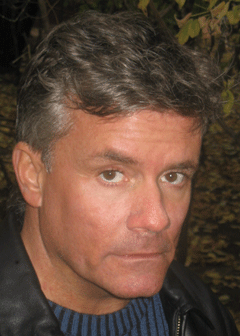
Photo: (c)Tatyana Shchukina
[WIND]
GELLERMAN: An icy wind sweeps across the frozen tundra of Lake Baikal, Siberia, Russia. Here in the vast expanse Stalin exiled millions to Gulag prison camps….
A horrible place then, a harrowing place now, as Jeffrey Tayler found when he traveled up Siberia’s Lena River. It’s the tenth largest in the world. Tayler chronicles his journey in his book, “River of No Reprieve: Descending Siberia’s Waterway of Exile, Death, and Destiny.” He joins us from Moscow. Jeffrey, Z’drastvotya.
TAYLER: Z’drastvotya.
GELLERMAN: Kadk dela?
TAYLER: Chadasteo, oo vas tiya.
GELLERMAN: I’m fine, thank you very much. I appreciate you taking the time to talk with us.
TAYLER: Sure.
GELLERMAN: Your trip up the Lena River sounds, well, on the one hand terrific, and then you’ve got this awful place. Can you describe it, and why you would possibly want to go up this river?

(Photo: (c)Tatyana Shchukina)
GELLERMAN: And in the summer it gets intensely sweaty and hot.
TAYLER: Yeah, once you get out of the highlands near Lake Baikal then the river drops into this bog and flat land where it can go up to 105 and it was easily close to 100 during a stretch of this trip. There were certainly a lot of insects. You wouldn’t be able to last very long out there. Even out on the river they tended to they followed us.
GELLERMAN: What did you use to fight them and fend them off?
TAYLER: I wore a protective hat with a net because otherwise you would just breathe them in and choke on them. And my guide didn’t bathe. He thought that by not bathing his skin would become clogged and emit less of an attractive smell to the insects. So that was his approach to it.
GELLERMAN: That’s your guide, Vadim He’s quite a character. I mean he’s like your companion, your travel guide. He’s this curmudgeon. You describe him as a tragic figure.
TAYLER: Yeah, I think he was...even though I hired him to take me down the river, he basically gave me the feeling the whole way that I was almost like an unwelcome guest on his excursion. And he’s decorated with war heroes for fighting in Afghanistan and he was an extremely strong person, which he still is, but disdainful of humanity in general. And the only thing he really likes are the woods and the tundra and that’s why he did the trip for me.
GELLERMAN: There were many places in the book that were dangerous but there was one place where you almost buy the farm. Can you tell us about that?
TAYLER: I think you mean the pipe. It was about 80 miles long as I recall. It was a section of the river where, the very very wide river, 9 or 10 miles wide in many places, shrinks into what looks like a pipe. And all of that water goes rushing through, probably about not even a half mile. And the current is very strong and the waves are very high. And we had this terrible wind. So we navigated that and then that led us right out into the Arctic Ocean into what were probably the most dangerous parts of the trip.
GELLERMAN: I know, 8-foot breakers, you got the temperature of the water is less than 40 degrees. Vadim’s not wearing a life jacket.
TAYLER: Yeah, neither was I. I mean there was no point in wearing a life jacket, given that if we’d fallen in the cold would have given us hypothermia, so we wouldn’t have been able to get ashore.
GELLERMAN: You traveled through the republic of Sakha and meet the Yakuts. Who are the Yakuts?
TAYLER: They’re a Turkic people that basically moved out of Central Asia during the era of migrations when Genghis Khan and others where setting themselves up. And they moved north and they kept moving north. And now they’re one of the many minority peoples of Russia. And they have a huge republic. I think it’s the size, oh I think it might be the size of Western Europe.
GELLERMAN: Yeah, and they have only a million people.
TAYLER: Yeah, they have practically no people. It’s just taiga and tundra.
GELLERMAN: You tell the story of a myth, a Yakut myth that takes place in a place called simply the pillars. Would you mind reading a little piece of that?
TAYLER: Ah, sure. (reading) “Once, eons ago, legend has it, the pillars were castles of gold. The demesnes of a vicious flying dragon. The dragon terrorized the Yakuts and extracted tribute. Hearing of a Yakutian beauty named Kere Kyys, the dragon demanded that they hand her over. They did. But the chaste Yakutian maiden happened to be born to a great shaman and engaged to a fearsome hunter named Khorson Uol, and had no intention of remaining the beast’s concubine. She tricked him into revealing the locus of his magic powers: his tail. During the fateful duel between Uol and the dragon, Kere shouted this vital piece of intelligence and – whop! – Uol lopped off the tail. All at once the castles of gold metamorphosed into the Lena Pillars. Uol turned to stone and a tree sprouted where the shaman stood, on which Yakuts to this day hang shreds of cloth for good luck.
GELLERMAN: You actually met a shaman.
TAYLER: Yeah, I did in Yakutsk the capital of Sakha. He performed a sort of a detoxification rite on us. And he probably is the only shaman in Yakutia who has his own website.
GELLERMAN: (laughs) Well, detoxification, he probably has his work cut out for him because it seems every stop along the Lena River you run into people who are drop down drunk.
TAYLER: Yeah, I suppose. Heavy drinking, as you know, is a part of Russian life. But out there very often people tended to just drink throughout the day in smaller doses. So it wasn’t, not everybody was drunk, but there were a good number of people who were sort of two sheets to the wind, starting early in the morning. And the mortality rate as a result is very high.
GELLERMAN: There is this overwhelming sense in the book, and it repeats again and again and again, about a kind of hopelessness; a pervasive sense of despair among the people that you meet along the river.
TAYLER: Yeah, I think that maybe despair and anger sums it up. Although people were living basically unmolested out amidst these beautiful woods on this great river, that people did value. But as far as politics went, and the idea of getting any help from the state, they were hopeless.
GELLERMAN: Vadim is a man who believes in very few things. At one point though, he says, “Russians are a herd, they can only be ruled by force.” What did he mean?
TAYLER: Yeah, well, I think he’s articulating the view of a lot of people who have imbibed the lessons of Russian history. I don’t agree with that. I think the future of Russia lies in disagreeing with looking at humans as cattle that have to be whipped into line. But one aspect of the national psychology is to see the strength of a people in the might of the state. And the mighty state herds and whips its people ahead. And he was referring to what he thought were bad years, the Stalin years, in part, but also when the country was feared. And a lot of Russians feel now that Russia is no longer feared and they are sort of ashamed of it.
GELLERMAN: I was wondering what music we’d play with this piece.
TAYLER: Um, it would seem like – do you know that song....
GELLERMAN: Umm-umm
TAYLER: It’s sort of like oh my native land is so broad or wide or. It was, I think Stalin had it written. I don’t remember the composer. But it certainly gives the majesty of the landscape, these endless forests and bogs and it’s a great Soviet era song. One of the most famous.
GELLERMAN: Well Jeffery, spaseeba bolshoi.
TAYLER: Nezhezdah.
[MUSIC: Shiroka Strana Moya Rodnaya “How Broad is My Country?” from Russian Film Soundtrack (Archives - 1944)]
GELLERMAN: Jeffrey Tayler’s new book is called “River of No Reprieve: Descending
Siberia’s Waterway of Exile, Death, and Destiny.”
Related link:
River of No Reprieve: Descending Siberia’s Waterway of Exile, Death and Destiny
Just ahead: a fashionista models the latest in eco-wear. Keep listening to Living on Earth.
Since you enjoy listening to Living on Earth, chances are you have some pretty good ideas about things that the program should cover. Good news, bad news, or just plain interesting stuff. If you think it would make a worthwhile story for the radio, please get in touch. You can zap us an email at comments@loe.org. Or call the LOE listener line at 800-218-9988. That’s 800-218-9988. Or write 20 Holland Street, Somerville MA 02144.
[MUSIC: Kaki King “Everybody Loves You” from ‘Everybody Loves You’ (Valour Recordings - 2003)]
Energy Brat?
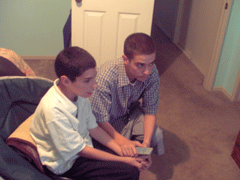
Youth Radio reporter Antony Jauregui and his younger brother Alexis battle over the remote control.
GELLERMAN: It’s Living on Earth. I’m Bruce Gellerman. As temperatures begin to drop, heating bills rise. But it’s not a concern for your average teenager. And as Youth Radio’s Antony Jaureguí admits he didn’t think much about it. After all, he grew up in sunny Southern California. But on a recent trip to his parents’ hometown in Mexico, he began to question why he never questions his energy use.
[APPLIANCE SOUNDS]
JAUREGUI: This is the sound of convenience in my house. Microwave, television, computer, stereo. We use these appliances a lot. My 14-year old brother Alexis is the main culprit. He leaves the lights on and appliances unattended. I try not to waste that much energy. I caught him upstairs playing on the computer and a hand-held video game- called a DS- at the same time.
ALEXIS: I’m not on the computer and the DS at the same time only the computer and TV.

Youth Radio reporter Antony Jauregui and his younger brother Alexis battle over the remote control.
ALEXIS: No that’s crazy. You’re the one who does it!
JAUREGUI: I use it more than you?
ALEXIS: Of course. You sleep with the radio on and you don’t turn it off until the morning!
JAUREGUI: That’s not true
ALEXIS: You told me 5 times! (laughs)
JAUREGUI: Ok, maybe we both use more energy than necessary. But my parents have tried to teach us to be mindful about energy. They grew up in a totally different era in a small town in Mexico.
DAD: I used to pick up some manure of the cow and also the manure of the donkeys.
JAUREGUI: Here’s my dad talking about his first lesson in energy.
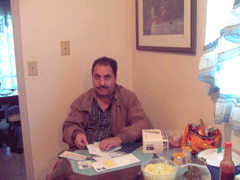
Youth Radio reporter Antony Jauregui says he and his father have different perspectives on energy consumption, because his dad grew up in a rural part of Mexico.
[SOUND OF GAS VENDOR]
JAUREGUI: That’s the gas delivery man in my dad’s hometown- Jalostitotlan. He's saying 'gaaaaaaa-aaaaaassss'. He’s shouting out the window of his truck to sell tanks of gas to the townspeople. This summer, I visited my family there and learned about energy in a new way.
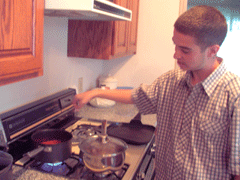
Youth Radio reporter Antony Jauregui prepares a meal using the gas stove in his house. Before his trip to Mexico, Antony says he never though about how much energy he uses on a daily basis.
[GREETINGS IN SPANISH]
I stop by my neighbors to ask what’s it all about? The person who answers in an elderly lady named Yermina Gonzalez.
YERMINA: Es bueno el systema porque ahorra uno a dinero se conserva la agua como 3 a 4 dias quando el tiempo esta malo y eso es lo que nosotros hemos visto. Quando el tiempo esta bien siempra hay agua caliente. Valle tener un sistema asi un systema solar.
JAUREGUI: She tells me the panels are her solar-powered water heating system. She says that over the past 25 years she has conserved not only gas, but also tons of money.
It seems like energy use is on peoples’ minds here more than in LA. This makes me wonder: am I an energy brat? When I’m home in LA, I even complain about going outside to put my clothes in the washing machine. Here at my grandma’s in Jalisco, I’m getting used to being the washing machine.
JAUREGUI: (tape) Now I’m doing laundry. Here it’s all hand washed. You get the water from this water pipe, it’s like inside the toilet, it’s like a little pump and the water runs out. And I just scrub. [Sigh]
DAD: When you go through trouble getting something, then you really appreciate what you have.
JAUREGUI: I’ve always had energy at my fingertips, so I haven’t really thought about where it comes from and how much I use. My parents have had it harder. And maybe that’s where they get their mentality about energy.
DAD: Like I don’t know if you remember where your mother used to live on the top of the hill. She used to go down there to get the water. She had to walk a lot to get some water so now when you guys or me even use a lot of water, she really gets upset because she knew how hard it was to get the water and now that we have the water sometimes we waste it.
JAUREGUI: I always thought that my mom was just tripping on me whenever I left the water running. But now I understand the chill that must run through her spine when she sees me waste water. Now that I’m back at LA, I am more dedicated to saving energy. Not only do I turn off the lights, but I’ve even caught myself looking through articles on energy conservation and careers. I used to think energy was only an issue in my house, but now I realize that it’s an issue affecting the whole world.
For Living on Earth, I’m Antony Jauregui.
GELLERMAN: Our story was produced by Youth Radio.
Related link:
Youth Radio
[MUSIC: Kinky “Soun Tha Mi Primer Amor” from ‘Kinky’ (Sonic 360 – 2002)]
Green Fashionista
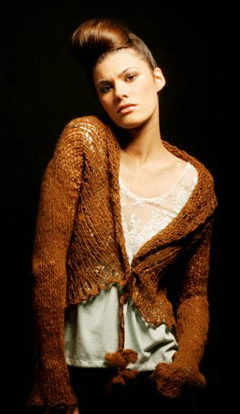
Fashion consultant Summer Rayne Oakes (Photo: Lauren Maud)
GELLERMAN: If fashion consultant Summer Rayne Oakes has it right soon you could be wearing the latest in bamboo. That’s right, bamboo, the stuff that panda bears eat.
You see, in addition to being a fashion consultant, Summer Rayne Oakes is also an eco-model and something of an expert in toxic sludge. Summer Rayne Oakes joins me from New York and thank you very much.
OAKES: Thank you for having me.
GELLERMAN: You were an undergraduate at Cornell, you were something of a bookworm, you studied entomology, ecology, and natural resource management. You even published a couple of papers in scientific journals I understand.
OAKES: Yes, that’s correct. I published, uh, two papers regarding the health related incidences revolving around the land application of sewage sludge. And the second one was on organic contaminants found in sewage sludges.
GELLERMAN: This was not a conversation you would ordinarily hear on a, on a catwalk. What’s a fashion model doing talking about, learning about and writing about toxic sludge?
OAKES: It, well it was, I was doing both research, and modeling while in college and bringing it back to my research in sewage sludge I was seeing a lot of toxic contaminants that actually get put into the earth through textiles, whether it’s, you know, not to go off, but nodal phenols or lineal aclobenzolsulfates are found in our detergents. So when we wash our clothes they actually go back into the environment. Brominated diphenolethers are put on our textiles as a flame retardant and they go right back into the sewage sludge and gets reapplied on our land. And I was seeing all these connections just on the environmental level and I was like jeez, you know, why try to regulate for these contaminants when we can go to the root of the problem and look at how we could build more sustainable ventures within the textiles and apparel industry, which by the way is a huge industry. It’s, it’ll be approaching probably 600 billion by 2010.
GELLERMAN: You know when I think of kinda sustainable fashions, I, I get an image of a burlap sack. Not, not, not very glamorous I’m afraid.
OAKES: I don’t know what sustainable fashions you’ve been looking at cause I’m not wearing a burlap sack today
GELLERMAN: What, what, what would you be wearing right now?

Fashion consultant Summer Rayne Oakes (Photo: Lauren Maud)
GELLERMAN: Bamboo, how could you use bamboo to, to make clothes?
OAKES: Well bamboo is, there’s a couple different ways to use bamboo but the most commercially viable way is actually using it as a rayon process. So the argument, among people within the textile arena is like, ah Rayon! You know, you have to use a lot of caustic to break it down and that is, that’s true. And the rayon process has actually improved through the years but the argument is, take bamboo as a fiber, you know, it’s a woody grass, it’s grass. You don’t need to apply pesticides on it, it just grows and you can cut it down and then it continues to grow. So what they do is they take like a three to five year bamboo which is usually called, it’s moso bamboo which is actually technically not the stuff that panda bears eat, just to clarify. But they take the moso and they put it into a process, the rayon process and the fiber come out like spaghettis and then all of a sudden you have a fiber and it’s become quite a hit on the fashion scene and it’s, it’s growing rapidly
GELLERMAN: So your interest if I understand it correctly is to help create a, a sustainable clothing industry?
OAKES: The goal is, is pretty broad. It’s to really work with companies and individuals on figuring out how to do better design, really looking at the whole supply chain. So, where are your products coming from? How are they being made? Who’s making them? What are they being dyed with? And the industry also has changed rapidly within the last 10, 20 years. It’s gotten to be more global. So really taking a look at where are the products being made and being shipped off to and figuring out how we can be more efficient along the supply chain and how that connects to carbon emissions is also very important.
GELLERMAN: Well I dare say just about everything I wear it was made in, in China.
OAKES: Yeah, and I think that is something that we need to tackle. I don’t think that’s going to change anytime soon. So then I would venture to say to some of the companies, let’s look at the practices, that if they’re being done in China, let’s look at labor laws. Let’s look at the dyes that are being used, the types of fibers that were being used. Can we go with a more organic fiber as is something that is synthetic and toxic?
GELLERMAN: It, it seems to me that you’re trying to do for the fashion industry what’s been done in the last few years with the organic food industry.
OAKES: Yeah, I think, uh, fashion apparel is definitely going to follow the same route that the organic food industry has had on consumers except that, ya know, organic food is easier for people to understand because they’re actually ingesting it and the apparel industry is a little less apparent in people’s lives but it is also a lifestyle choice and I think that’s really what’s going to hook people in is really seeing, you know, the food that they eat, what the clothes that they wear say about them.
GELLERMAN: Well, Summer, thank you very much.
OAKES: Thanks for having me.
GELLERMAN: Summer Rayne Oakes is an eco-model and fashion consultant working in New York City.
Related links:
- Summer Rayne Oakes' website
- SRO company website
- ECOFASHION 101 website
- “Behind the Label” website
[MUSIC: The Blue Hawaiians “White Christmas” from ‘Christmas on the Big Island’ (Restless Records/Rhino Entertainment – 2006)]
Green Giving
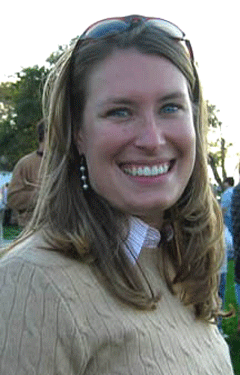
Kara DiCamillo compiled treehugger.com’s Green Gift Guide.
This year, are you dreaming of a green Christmas? As you shop for your Christmas, Hanukkah and Kwanza gifts, do you feel a bit guilty that you're contributing to the extra 25 million tons of trash Americas will generate during the gift giving season? Well, you don't have to say ‘bah humbug’ and give lumps of coal. There are green alternatives, and joining us from Newport, Rhode Island is Kara DiCamillo. She put together the Green Gift Guide for the website treehugger.com. Hello, Kara.
DICAMILLO: Hi, Bruce. How are you?
GELLERMAN: I’m well, thank you. You know, when I hear tree hugger I think, well I think kinda crunchy granola, tie dye and hippie…
DICAMILLO: Hippie.
GELLERMAN: Yeah, exactly. Is that what you got here?
DICAMILLO: Well, not exactly. Our motto is hip not hippie. I mean don’t get me wrong we love the hippies and they are definitely the backbone of the environmental movement but, I mean lets face it, there is a negative ring to it as well. But the stuff that we feature on tree hugger as a whole has a modern aesthetic to them and, uh, there’s just so many options out there right now that allow people to lead an ecofriendly lifestyle.
GELLERMAN: Well let’s talk about some of the more unusual gift ideas. I like the one from the natural resources defense council. It’s something to watch skunks by moonlight.

Kara DiCamillo compiled treehugger.com’s Green Gift Guide.
GELLERMAN: It’s a night spotter scope.
DICAMILLO: Right, right. We have a lot of cool items like that on there. Um, the big trend this year is solar and we have a lot of solar options. It actually has its own category this year as well so.
GELLERMAN: Yeah. I was doing a bit of research and I found out that 40 % of the batteries used in the United States are used and bought during the holiday season. So what are the alternatives?
DICAMILLO: Some of the things that we featured in 2006, one of them was a solar video camera, which is very cool. Another one is a solar wireless camera. And another good one for the outdoors people is the solar powered tent. I don’t want to give it all away here, but. Those are just some of the solar things that we’re gonna feature.
GELLERMAN: I like the solar powered laptop.
DICAMILLO: Oh, Yeah. Solar powered laptop and we have a solar powered backpack to go along with that. Um, you can stick the laptop right in there and it charges just from being in the back pack.
GELLERMAN: What are some of the other cool ideas?
DICAMILLO: Also another big trend this year is bamboo. There is a company called Bamboo and they have everything from kitchen utensils to cutting boards. I’m a big foody myself so I have a lot of bamboo products in my home.
GELLERMAN: Well for Chanukah you have some sustainable gifts I noticed, um, beeswax candles.
DICAMILLO: Yes. Beeswax and soy candles. Those are both very good as opposed to using candles that might emit, you know, really bad stuff into your air and you don’t want that around the holidays.
GELLERMAN: Kara, what’s your stocking stuffed with this year?
DICAMILLO: I love the idea of crazy crayons. The company, through their recycle program, they accept old crayon stubs and melt them down to make new ones. So that’s definitely something that should be a stocking stuffer in every kids stocking this year. And I love, and this can be stuffed in my stocking, I love Vere Chocolate. The company is based out of New York City and their pieces of chocolate, if you can believe this Bruce, their chocolate, just one piece, has less sugar than an apple, more antioxidants than a glass of wine and more fiber than a pound of broccoli. That sounds good to me. And I’m a big outdoors person so I love the Teko socks. Um, I can use them for when I hike and they’re also made out of organic materials.
GELLERMAN: And you could use those as your stocking?
DICAMILLO: Yes you can. That’s a very good point.
GELLERMAN: Kara DiCamillo is a writer for Tree Hugger.com. She created the websites green gift guide. Thank you very much.
DICAMILLO: Thank you very much. It was very great talking with you.
Related links:
- Treehugger.com Holiday Gift Guide
- “How to Green Your Gifts”
[MUSIC: Madonnowl “Greensleeves” from ‘A Froggy Christmas’ (Leapin’ Records – 1996)]
GELLERMAN: During the World Wars, homing pigeons were heroes and helped save the lives of thousands of soldiers. Next week on Living on Earth, we salute the humble pigeon.
_____For ten thousand years, pigeons were considered our very best friends and just in about the last fifty years, they’ve just been utterly vilified as vermin by the pest control industry.
GELLERMAN: We drop in on pigeons for a change on the next Living on Earth.
GELLERMAN: We leave you this week with a horse tale.
[TALKING AND BOW FIDDLE TUNING UP]
GELLERMAN: Horses have been considered sacred on the Mongolian steppe since the days of Ghengis Khan and for centuries fiddlers have fashioned bows from the tail and mane of the honored animal. Living on Earth's Ian Gray recorded this horse-bow fiddler along the trans-Mongolian route near Ulan Bator.
[FIDDLE SOUNDS]
GELLERMAN: Living on Earth is produced by the World Media Foundation. Our crew includes Ashley Ahearn, Eileen Bolinsky, Tobin Hack, Ingrid Lobet, Emily Taylor and Jeff Young - with help from Bobby Bascomb, and Kelley Cronin. Our interns are Ian Gray and Jennifer Percy. Dennis Foley is our technical director. Our executive producer is Steve Curwood. Alison Lirish Dean composed our themes. You can find us at loe dot org. I’m Bruce Gellerman. Thanks for listening.
[HORSE NEIGHING FIDDLING]
GELLERMAN: And, that ain’t hay.
ANNOUNCER: Funding for Living on Earth comes from the National Science Foundation, supporting coverage of emerging science; And Stonyfield Farm organic yogurt and smoothies. Stonyfield pays its farmers not to use artificial growth hormones on their cows. Details at Stonyfield dot com
Support also comes from you our listeners, the Ford Foundation, the Oak Foundation, and the Saunders Hotel Group of Boston's Lennox and Copley Square Hotels. Serving you and the environment while helping preserve the past and protect the future, 800-225-7676.
ANNOUNCER 2: PRI. Public Radio International.
Living on Earth wants to hear from you!
Living on Earth
62 Calef Highway, Suite 212
Lee, NH 03861
Telephone: 617-287-4121
E-mail: comments@loe.org
Newsletter [Click here]
Donate to Living on Earth!
Living on Earth is an independent media program and relies entirely on contributions from listeners and institutions supporting public service. Please donate now to preserve an independent environmental voice.
NewsletterLiving on Earth offers a weekly delivery of the show's rundown to your mailbox. Sign up for our newsletter today!
 Sailors For The Sea: Be the change you want to sea.
Sailors For The Sea: Be the change you want to sea.
 The Grantham Foundation for the Protection of the Environment: Committed to protecting and improving the health of the global environment.
The Grantham Foundation for the Protection of the Environment: Committed to protecting and improving the health of the global environment.
 Contribute to Living on Earth and receive, as our gift to you, an archival print of one of Mark Seth Lender's extraordinary wildlife photographs. Follow the link to see Mark's current collection of photographs.
Contribute to Living on Earth and receive, as our gift to you, an archival print of one of Mark Seth Lender's extraordinary wildlife photographs. Follow the link to see Mark's current collection of photographs.
 Buy a signed copy of Mark Seth Lender's book Smeagull the Seagull & support Living on Earth
Buy a signed copy of Mark Seth Lender's book Smeagull the Seagull & support Living on Earth

